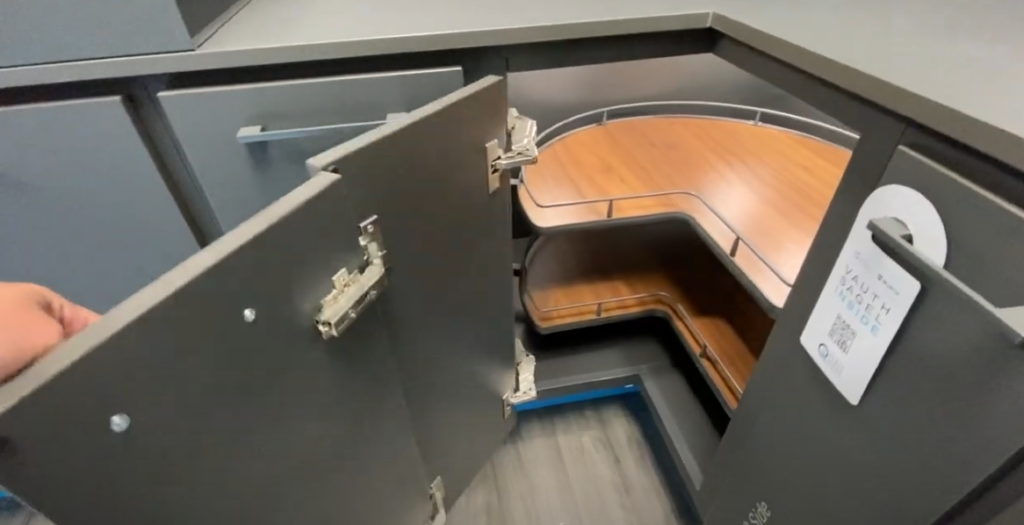Are you trying to learn how to install a Lazy Susan? Look no further than our comprehensive guide below!
We’ve helped install hundreds of Lazy Susans in kitchens across the country. The truth? Most people think they need a professional to install one. They’re wrong. With the right steps, you can do this yourself in under 2 hours.
Here’s what most DIY guides won’t tell you: 80% of Lazy Susan installation problems come from wrong measurements and poor planning. Not the actual installation. That’s why this guide focuses on preparation as much as the installation steps.
Think your corner cabinet is too awkward? Too small? Too old? Good news – there’s a Lazy Susan solution for every cabinet type. I’ve seen successful installations in cabinets from the 1920s to modern IKEA units.
This guide breaks down the entire process into simple steps. You’ll learn which tools you really need (hint: it’s fewer than you think), how to pick the right type for your space, and the exact installation steps that work every time.
The best part? You’ll save $200-400 in installation fees. Plus, you’ll gain a skill you can use again or share with others.
Let’s transform that frustrating corner cabinet into the most useful space in your kitchen.
How to Install a Lazy Susan: Step-by-Step Lazy Susan Guide
- Collect tools like a screwdriver and tape measure.
- Choose the right Lazy Susan for your cabinet.
- Follow step-by-step guide for installation.
Step 1: Gather All Necessary Lazy Susan Installation Tools
First, gather all the tools you’ll need for the installation. You will need a screwdriver, a drill with bits, a tape measure, a pencil, and safety glasses. These are the basic tools to ensure precise measurement and correct installation.
You can find these tools right here on Woodworker Express. Some might already be in your toolbox at home, but we can help you with any missing tools (and the Lazy Susan!)
[TIP: Consider borrowing tools from a friend or renting from a local shop if you don’t want to purchase them.]
Step 2: Choose the Right Lazy Susan Cabinet Type
Different types of Lazy Susan cabinets suit different kitchens. Let’s break them down:
- Full-Round Lazy Susan: Best for large corner cabinets. It rotates fully around and works great for accessibility.
- Half-Moon Lazy Susan: Better for tighter spaces. It slides out and then rotates, suitable for small cabinets.
- D-Shaped Lazy Susan: A middle ground between full-round and half-moon designs.
- Pie-Cut Lazy Susan: Excellent for corner cabinets with bifold doors.
- Kidney-Shaped Lazy Susan: Use this for unique corner spaces.
Your kitchen’s layout will affect your choice. Consider cabinet space and configuration before choosing. The types of Lazy Susan corner cabinets provide detailed insight into these options.
Step 3: Install the Lazy Susan
Measure and Mark Your Cabinet
Use your tape measure to measure the space inside your cabinet. Ensure it will fit your chosen Lazy Susan type. Mark the drilling points with a pencil. This helps place the Lazy Susan correctly.


Attach the Hardware
Take your drill and create holes where you marked earlier. Wear safety glasses to protect your eyes. Use the screwdriver to attach the hardware securely. Make sure everything aligns properly. The Lazy Susan should be secure but still able to rotate smoothly.
Position and Secure the Shelves
Place the Lazy Susan shelves onto the installed hardware. Spin the shelf to ensure a smooth rotation. If it feels tight or wobbly, adjust the screws to balance tension.

Step 4: Finishing Touches
Once installed, check for smooth rotation. Rotate the Lazy Susan several times to ensure it spins evenly. If it is hard to turn or gets stuck, adjust the screws until the movement feels smooth and easy.
Next, test the stability and fit by placing items on the shelves. If items wobble or shift, tighten the hardware slightly. This should stabilize the Lazy Susan and help items stay in place. Proper installation ensures easy access and enhanced storage capacity.
This wraps up the step-by-step instructions for installing your Lazy Susan. But there’s more to learn about making the most of your new setup.

Advanced Tips for Lazy Susan Installation
- Advanced mounting techniques can solve unique cabinet issues.
- Avoid major errors by checking measurements and alignment early.
- Enhance user experience by tackling common installation pitfalls.
Additional Advice or Alternative Methods
Different Mounting Techniques
Discussing different mounting techniques is crucial for those dealing with unique or unconventional cabinet shapes. Using adjustable mounting brackets or custom-built systems can accommodate these challenges. Custom options often provide better integration and functionality, though they may require more skill. Unmatched precision in measurement and fitting will often lead to the best results, ensuring stability and ease of use over time.
Tips for Unusual Cabinet Shapes
Handling unusual cabinet shapes doesn’t have to be daunting. One effective approach involves adjustable shelving systems, which offer flexibility in fitting diverse dimensions. Precision in measurement becomes paramount. Using a level and square ensures accuracy during installation, a critical point since misaligned shelves can lead to operational issues. Attention to detail helps address challenges like non-standard heights or widths.
Experiment with innovative arrangements, perhaps inspired by modular furniture design literature, which can offer new perspectives.
Common Pitfalls and How to Avoid Them
Measurement Errors
Measurement errors often undercut even the best-laid plans. Ensuring correct dimensions involves meticulous planning. This process requires a focus on detail during both the planning and execution phases. Using tools like a tape measure, level, and square can confirm accuracy.
Mapping out not only the space but also the interaction of moving parts, such as revolving shelves, is crucial to project success.

Potential Alignment Problems
Potential alignment problems haunt many lazy susan installations, often stemming from faulty positioning or inconsistent spacing. Misalignment makes operation cumbersome and might damage the mechanism over time. Preventing these issues requires preliminary checks and continual verification throughout the assembly.
A recurring tip is to use simple tools like golf tees for micro-adjustments to the cabinet doors, ensuring seamless motion and proper fit. The significance of alignment speaks volumes of planning and execution quality, as it is essential for longevity.
Troubleshooting Common Issues
- Fixing a Lazy Susan can be straightforward.
- Many problems are easy to identify and resolve.
- Gaining the skills to fix these issues saves time.
Solutions to Potential Problems
How to Adjust a Lazy Susan Cabinet: Fix Wobbling
Wobbling can make your Lazy Susan annoying to use. Let’s fix it. First, identify the cause. Usually, it’s loose screws or uneven carpet. Use a spirit level to check the flatness of the surface. If the floor isn’t level, adjust it first.
If your Lazy Susan is wobbling because of loose screws, tighten them. Use a screwdriver to secure all the fittings. Make sure all the screws on the Lazy Susan base are tightly fixed.
If wobbling persists, inspect the bearing ring. Make sure it is clean and free of any dirt or obstruction causing improper movement. Clean it with a dry cloth. Apply a small amount of lubricant to the bearing ring. This helps smooth the movement. Remember, not too much lubricant, as it can make things greasy.

How to Adjust a Lazy Susan Cabinet: Address Crooked Installation
A crooked Lazy Susan not only looks bad but can also cause things to slide off. Start by checking the alignment. Measure the cabinet opening from different angles. Confirm the alignment with a square tool. Ensure both the base and the top mounting hardware are even and secured.
If the Lazy Susan is not lining up, it may be due to the incorrect placement of the pivot point. Adjust the pivot point to ensure the shelves rotate correctly. Unscrew the mounting bolt closest to the pivot point. Slightly move the Lazy Susan and retighten the bolt.
Check to see if the circular plates are even. They should not tilt or slant. If they are uneven, adjust the mounting bracket. Loosen the bracket screws, gently adjust, and retighten securely.
Be meticulous with these adjustments to avoid more problems. Double-check all measurements and fittings. Proper alignment prevents issues down the road.
In case you need more visualization, diagrams are helpful. They clearly show where adjustments need to be made. A visual guide can significantly simplify this process. Stay patient. It’s a skill that gets easier each time.

How to Install a Lazy Susan: Conclusion
Installing a Lazy Susan has now become a task you can handle with confidence. With your new skills, you can transform that dark corner cabinet into a smooth, working storage space. The key steps – from choosing the right type to securing the hardware – are now part of your DIY skill set.
Think about what this means for your kitchen. No more stretching or bending to reach items at the back of cabinets. No more forgotten cans or expired food hidden in corners. Instead, you have a cabinet that works for you, making cooking and organizing smoother.
Take what you’ve learned today and put it into practice. Start with careful measurements, follow the installation steps closely, and test your work. If you run into issues, remember the troubleshooting tips we covered. Small adjustments often make big differences in how well your Lazy Susan performs.
Your next step is simple: gather your tools and start your project. Soon, you’ll open your cabinet to find a perfectly installed Lazy Susan, ready to make your kitchen life easier. Your future self will thank you for taking the time to do this right.




